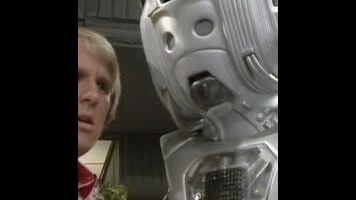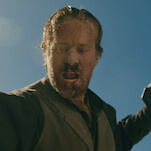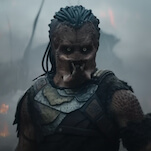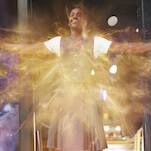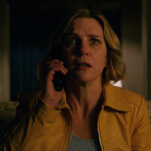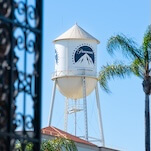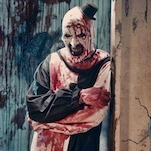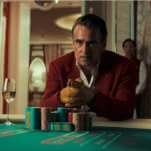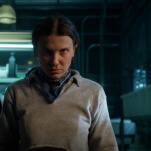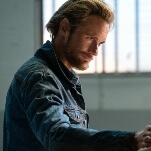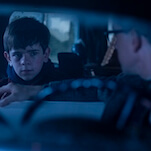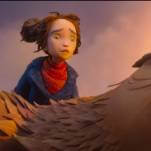“The Brain Of Morbius” (season 13, episodes 17-20. Originally aired Jan. 3-Jan. 24, 1976)
The first thing we see in “The Brain Of Morbius” is a monster. That’s not exactly unusual on Doctor Who. It’s a man-sized insect, crawling out of the wreckage of its crashed spaceship and obviously wounded or even dying, across a rocky, fog-shrouded landscape. (Longtime viewers will recognize it as a Mutt from the Jon Pertwee-era serial “The Mutants,” which is also a clue that this creature, grotesque as it looks, isn’t the villain of the piece.) The thing that tells us we’re getting into some darker territory than usual is that this monster is being stalked by another monster. A hulking, hook-handed ogre looms out of the shadows and brutally murders the poor creature with a wicked-looking blade. The scream is horrible.
So where have we landed this time? Well, the planet itself is Karn, a desolate place near the Doctor’s homeworld of Gallifrey, and thus tied to his personal history in a way rarely seen on the show up to this point. We’ve also landed, in terms of our trip back and forth through the ages of Doctor Who, right in the middle of the early Fourth Doctor era, the time of the remarkable three-year partnership of producer Philip Hinchcliffe and script editor Robert Holmes—what I like to think of as the “Sci-Fi Gothic” era, and for my money, the high point of Doctor Who. “The Brain Of Morbius,” credited to the pseudonym “Robin Bland” but written largely by Holmes (drastically revising Terrance Dicks’ original idea), is a gloriously lurid gem, and maybe the quintessential story of the Hinchcliffe era. And despite some plot holes, it’s also my single favorite Who story.
The dividing line between science fiction and horror is often unclear, and the two genres frequently bleed into each other, pardon the pun. No era of Doctor Who embraced that as much as this one, roughly bracketed by 1974’s “The Ark In Space” and 1977’s “Image Of The Fendahl,” and dominated by smartly done pastiches of earlier sci-fi and horror classics. That had always been part of the show’s m.o. (“The Daleks” leaned heavily on H.G. Wells, for instance), but never so consciously or to such great effect. Here’s Hinchcliffe himself explaining things: “We had a deliberate plan to raid the whole genre of science fiction in all its manifestations, from sword-and-sorcery to the gothic strain but avoiding the Earthbound setting of a present-day Doctor fighting an invasion from space. All that had been done. What we wanted was to take the viewer into a more fantastic scene… Bob and I wanted to fertilize Doctor Who by borrowing from richer and more well-known themes from acknowledged classics.”
Between this thematic approach and Tom Baker’s wild-eyed charisma, the Hinchcliffe era was both an artistic and popular triumph, piling up an impressive list of serials that not only pulled in high ratings but have stood the test of time better than any other era. That’s not to say it didn’t have its share of misfires, and the controversy over its increased violence and horror eventually got Hinchcliffe shuffled off to a different show after a lengthy campaign from moral crusader Mary Whitehouse. The tone of the show lightened (by executive mandate) under the next showrunner, Graham Williams, particularly after he hired Douglas Adams as script editor.
Even without knowing Hinchcliffe’s explanation, viewers couldn’t have failed to see the strategy, since the homages were always fairly obvious and upfront. “Pyramids Of Mars” evokes Boris Karloff’s The Mummy. “Seeds Of Doom” riffs on The Thing. “The Talons Of Weng-Chiang” leans on both The Phantom Of The Opera and The Insidious Dr. Fu-Manchu. “The Brain Of Morbius” is most obviously a Frankenstein riff, but there’s a lot more going on; we’ll get into that in a moment. The important thing is, these stories wouldn’t have worked so well if they’d been merely parodies or rip-offs, no matter how cleverly done. Instead, they rearrange the originals in new ways, combining and shifting the elements and giving the old stories a new spin that made them uniquely part of the Doctor Who universe. “The Brain Of Morbius” doesn’t just trade on nostalgia for old movies, it actively expands the Doctor’s own story.
This probably wouldn’t have worked so well without the Fourth Doctor in the central role. We’ve already seen a glimmer of Four’s particular brand of eccentricity in his debut, “Robot,” but by this point in the series, Baker had perfected the role. The Doctor has always been a volatile personality, but this incarnation ratchets that to an extreme, bouncing from schoolboy petulance to lighthearted clowning to grimly serious, near-mystical harbinger of doom all within the same scene, and sometimes within the same sentence. Four could be whimsical and genially friendly if he felt like it, and then his mood might shift and he’d stare off into space as if he was consumed by thoughts of cosmic importance beyond human understanding—human and alien, witty and somber, full of lackadaisical whimsy and righteous anger simultaneously. In the second half of Baker’s run, that would too often devolve into a performance that was high-energy and over-the-top for its own sake, but the early Fourth Doctor was utterly magnetic in his unpredictability. And that allowed Hinchcliffe and Holmes to move toward darker and more luridly conceived stories, since they had a hero who could effectively keep things fun without destroying the creepy atmosphere a horror story needs to function, and indeed could shift the mood of the story as necessary just by the way he reacted.
Before I go any further I should finish setting up the plot at hand. The hook-handed killer is Condo, a brutish, ogre-like Igor figure in search of heads for his master, the mad scientist Mehendri Solon. But the Mutt head won’t work—he needs a very specific kind of cranium for his mysterious project, humanoid and (as we’ll see) ideally Gallifreyan. “One such specimen, just one, and I can complete my work here,” he glowers, with an obsessive glint in his eye.
And just a moment later Solon gets his wish, as the TARDIS, carrying the Doctor and Sarah Jane Smith, lands just outside his castle/laboratory. The Doctor bursts out in high dudgeon, convinced that the unseen Time Lords have hijacked him on purpose. And we never do find out for sure if that’s true, but it almost certainly is. At this point in the series, the Doctor was still under the lingering influence of his trial by the Time Lords in “The War Games,” which had led to an extended Earthbound exile and an even longer case of being used as an involuntary secret agent for Time Lord interests, which happened throughout the Pertwee era and in Baker shows like “Genesis Of The Daleks.” (Holmes’ working theory, in fact, was that even the supposedly fugitive First and Second Doctors had unknowingly been under Time Lord control ever since stealing the TARDIS and running away, but maybe that’s a topic to delve into when I get to “The War Games.”) Anyway, the Doctor’s indignant protests are cut short after Sarah points out a graveyard of wrecked spaceships, then stumbles on the body of the Mutt. Murder and mystery, and the game’s afoot. They go off to seek answers at the castle.
Their presence has been noticed by the other major faction in the story—the Sisterhood of Karn, a sinister all-female cult of flame worshippers who carefully tend the immortality-granting Elixir of Life. They’re paranoid and suspicious of outsiders, and in fact it’s the Sisterhood who are actually destroying the passing spaceships, not Solon—he’s just opportunistically looting the wrecks for usable body parts. Although they’ll soften their fanatical stance after the Doctor gains their trust by the end of the story, it’s typical of the Hinchcliffe/Holmes era that the Sisterhood is more morally complex than, say, the Thals in “The Daleks,” who were basically straight-up good guys. The Sisterhood has blood on its hands, and come across as a witches’ coven of stone-crazy xenophobes ready to burn strangers at the stake while hiss-chanting “Death! Death! Death! Death!” In a story that lacked Morbius and Solon, they could easily have carried the role of main villains all by themselves. But their behavior is at least understandable when you realize that they’re apparently the only people left alive on Karn, thanks to the genocidal wars of conquest led by a rogue Time Lord—Morbius. Imagine a single Tibetan monastery being the last refuge of humanity after invaders wiped everyone else out. Even the Dalai Lama might have an unwelcoming attitude. Maybe the Sisterhood was friendlier once—certainly, they were once on better terms with the Time Lords before Morbius made them fear all strangers.
The story of Morbius’ rampage and subsequent trial and execution, though left sketchy and vague, is also one of the tantalizingly few times that Doctor Who had spilled any details about the history of the Doctor’s homeworld up to this point in the series. The Time Lords had been a growing presence in the series ever since “The War Games,” but mostly unseen. Usually, they acted at a remove, using the Doctor himself as their pawn, as they’re clearly doing in this story. The fate of Karn, a planet near enough to Gallifrey to be affected by its politics and wars, could perhaps be the reason why they choose not to interact directly with the universe anymore—since it was a former member of their ruling council who incinerated this and apparently many other worlds.
And the trial must have happened within the Doctor’s lifetime but before he fled Gallifrey, since he talks about it as history he’s lived through when he meets Solon. Which means that the stakes here are more personal for the Doctor than usual. (It also raises the possibility that Morbius had something to do with why the Doctor fled, but that’s left unexplored.)
It doesn’t seem accidental that Holmes places Karn near Gallifrey, or that what’s left of its culture parallels the stagnantly ceremonial Time Lord society he depicted in “The Deadly Assassin” the following season. “Alone among all the races in our galaxy, the Time Lords are our equals in mind power,” says the wizened old leader Maren, making the Sisterhood a kind of weird gender-flipped version of the Time Lords, who had been presented thus far as a stereotypically patriarchal bunch. (I’m not sure if we’d even seen any female Gallifreyans yet other than Susan in the Hartnell era, when not much was yet established about Time Lords—that would have to wait until the introduction of Romana in 1978.)
Solon, for his part, is just as stagnated as the Sisterhood without the proper head to complete his Frankensteinian creation, and so the Doctor’s arrival catalyzes the story into action. Most of it involves the Doctor and Sarah shuttling back and forth between Solon’s castle and the Sisterhood’s cavelike temple, slowly breaking through the Sisterhood’s hostility while Solon aches to finish his work, Morbius impatiently awaits his revenge, and Condo pines for his lost arm.
Let’s pause here to count up some of the older stories being raided to create “Morbius,” a Frankenstein story appropriately stitched together out of homages. The mad scientist Solon, the Igor-like Condo, and the body made of corpse parts are all from Mary Shelley’s novel and the 1931 Boris Karloff movie, of course. The disembodied but living brain with its own agenda evokes Curt Siodmak’s similar Donovan’s Brain and the lesser but unforgettably high-concept They Saved Hitler’s Brain. Morbius’ giant lobster-like claw and the insect-like stalk-eyes on his brain’s transparent plastic skullcase evoke the body horror of 1958’s The Fly—where it’s also the head and right arm that are grotesquely transformed. The globe head and shaggy body might also be a reference to Robot Monster. Condo is Igor, but he’s also got a bit of the Hunchback of Notre Dame in him—and he’s also the story’s second Frankenstein monster, picking up the brute-with-tender-feelings aspect of Karloff’s version which don’t work with the intelligent Morbius. The Sisterhood come in at the end to play Frankenstein’s torch-wielding mob, but mainly draw from the sinister female immortality cult in H. Rider Haggard’s She. And Sarah Jane, struck temporarily blind and the unwilling subject of Condo’s infatuation, is thus tied to both the blind old man and the little flower-picking girl who encounter Karloff’s monster in the 1931 Frankenstein.
I’m sure there are other allusions, but those are the big ones. And the reason why they’re important is that the script isn’t just making hollow references for their own sake, but actively repurposing and intersecting them with each other. The plot is a web of motivations at cross-purposes: The Doctor and Sarah vs. Solon vs. Morbius vs. Condo vs. the Sisterhood, and you can probably throw in the Time Lords and the brain-damaged version of Morbius (who clearly feels differently about being a living monstrosity than the Morbius who proudly boasts about his new lungs). That’s a target-rich environment for conflict and compelling drama, and it works partly because Holmes has taken Donovan’s Brain and Frankenstein, two superficially similar stories that have entirely different dominant characters working as the plot driver, and has mashed them together to see what happens. I think the Condo/Morbius-monster fight to the death may also be a nod to Frankenstein Meets The Wolf Man (another Curt Siodmak story, oddly enough)—not a highfalutin’ literary or filmic allusion but an acknowledgement of that, in a story like this, your two hulking monsters damn well ought to have an awesome fight to the death.
But they’re also well-drawn characters in their own right, helped enormously by the generally solid cast, particularly the go-for-broke performances of Philip Madoc as Solon and Colin Fay as Condo. It’s great fun to watch Madoc’s utterly monomaniacal Solon, laser-focused on the mad science to the point where everything else fades in the background for him. He forgets about Sarah even though he’s four feet away from her, and calls the theft of Condo’s arm a “triviality” to his face even though he knows promising its return was the only thing keeping Condo from murdering him. He complains about being forced to use whatever body parts he can scavenge, but you just know he thinks deep down that replacing a hand with a giant lobster claw is exactly the right thing to do. “Any third-rate hack can fix an arm, but a head… That takes genius.”
The script isn’t perfect. For one thing, I’m not sure it’s in character for the Doctor to just straight up kill his enemies with poison gas, and it probably helped set a precedent that led to the overdone violence of ’80s Who. (Unlike Mary Whitehouse, I’m not opposed to onscreen violence, just poorly done onscreen violence.) And it’s hard to believe that Solon would really think that the Sisterhood would give him the Doctor’s head in exchange for letting them kill him. And it’s even harder to swallow the idea that the Doctor would tell Solon, who has already played him false at least twice, to dismantle the Morbius body that is his single, lifelong obsession, and then just leave the room and trust him to do it. (It’s not hard, though, to think that Condo is so stupid that he’s overlooked that his missing arm has been behind a flimsy curtain, practically in plain sight, this whole time.) But neither of those problems derail the story for me—they’re rushed and flawed but necessary methods of joining two plot points together. In the latter case, the Doctor’s unwarranted trust serves the purpose of getting him somewhere Solon could lock him away and then go finish properly connecting Morbius’ brain to the body. Since that final-stage Morbius is what this whole thing has been leading towards, an inelegant way of making that happen is forgivable.
Especially when it leads to the Doctor’s wonderful insult “Chop Suey the galactic emperor,” and to the dramatic apex of the story—the Time Lord mindbending contest between the Doctor and Morbius. The Doctor pretty obviously has this in mind from the moment the scene begins, and is deliberately goading Morbius into accepting the challenge—what’s less clear is whether he thought he could actually win, or if this was a Hail Mary. He seems confident enough, and calls himself “a mere nobody” in the tone of someone who knows he isn’t—not the only time Baker’s Doctor would suggest that he was far more powerful than he was letting on. But then, insofar as it’s possible to tell how the mindbending game is played, he seems to be losing badly, and of course he dies (temporarily) when Morbius’ braincase overloads. Morbius never speaks another coherent word, and goes over the cliff as a mindless animal. Whether or not he beat the Doctor, he lost, which had been the Doctor’s plan.
And of course, there’s the lingering question of the faces that show up on the screen between the battling Time Lords. The intention of the production team had been that the faces would show all the previous Doctors in reverse order, like he was mentally being forced backward through his life—audaciously going past William Hartnell to show even earlier incarnations, implying a much longer lifespan than the show had depicted. (They’re actually the faces of Hinchcliffe, Holmes, and several other crew members.) This was probably a bad idea just because it makes it harder to accept the necessary naïveté of the Hartnell Doctor if he wasn’t the first one, but it also wound up being one of those things that periodically sent hardcore fans into paroxysms of continuity nerd-rage, since it didn’t jibe well with the limit of 12 regenerations that Holmes himself set down in “Deadly Assassin”—meaning the Doctor had nearly used his all up. Later writers escaped this quagmire by simply ignoring it, which is probably the right thing to do. But even taking it seriously for a moment, it’s easy enough to find a way to make those Morbius’ faces instead, because it’s not like the rules are ever explained beyond three cryptic lines of dialogue from Morbius. Does it mean you’re winning or losing when your faces are onscreen? Who knows, no pun intended. Especially when you take into account that the Doctor’s goal wasn’t to win, but to make his enemy overstretch himself, those last eight pictures could easily enough be images of Morbius pushing on to victory, where the finish line is just a braincase of smoke.
Stray observations:
- Here’s a great example of the serial format using the cliffhangers well—ramping up the threat level of Morbius in three progressively more horrific encounters with Sarah, first the insensate body, then the hostile but powerless brain, then the awakened dual combination.
- Solon’s castle is apparently a decommissioned nuclear reactor; the Doctor calls it a former “hydrogen plant.”
- It’s also worth noting the strength of the set design. Even though “Morbius” was confined entirely to studio sets for budgetary reasons, it looks terrific, with deep shadows and murky lighting setting the proper horror-movie mood, and a striking color contrast between the sickly green-dominated castle and rich red/oranges of the Sisterhood.
- I would hardly want to trade Madoc’s performance for anything, but either of the two earlier casting ideas for Solon would have been fantastic: horror-movie icons Vincent Price and Peter Cushing (who’d played the Doctor in two 1960s movies as well).
Next week: Due to an unexpected scheduling conflict, I’ll be taking a one-week break next week. Back Sept. 4 with “Earthshock,” and then:
• Sept. 11: “The Aztecs”
• Sept. 18: “The Invasion,” episodes 1-4
• Sept. 25: “The Invasion,” episodes 5-8
• Oct. 2: “Terror Of The Autons”
• Oct. 9: “The Talons of Weng-Chiang”
• Oct. 16: “Kinda”
• Oct. 23: “The Dalek Invasion Of Earth”
